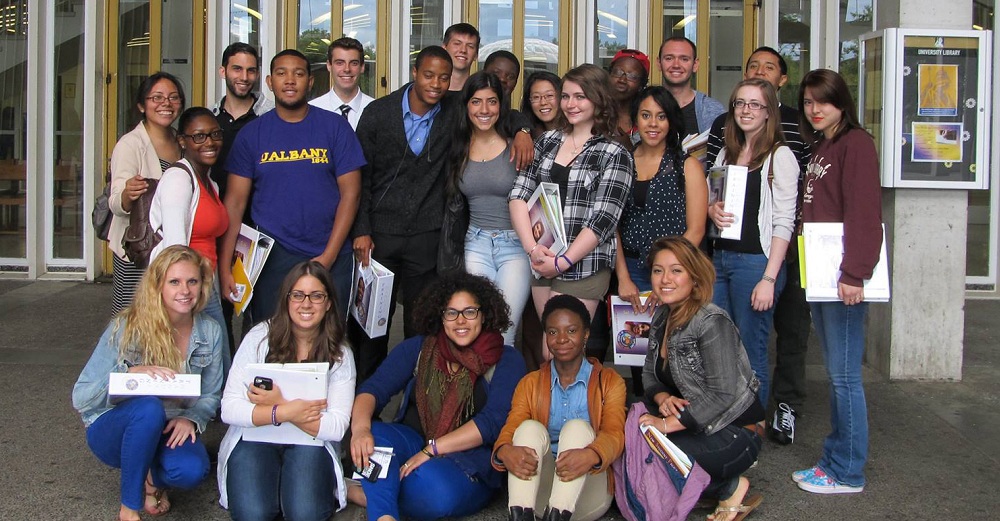The face of the United States is changing. By 2050 the caucasian population will no longer be the majority. And as the demographics of America change, SUNY strives to match them. Chancellor Nancy Zimpher’s Power of SUNY makes this goal exceedingly clear, stating that “Diversity enriches our lives and the educational experience: it invigorates conversations, awakens curiosity, and widens perspectives. Diversity also ensures that our campuses mirror the rapidly changing world, creating an environment that prepares our students to be culturally competent so they can succeed anywhere…”
SUNY has made great strides in this direction. As a percent of SUNY’s total enrollment, under-represented minority enrollment has grown from 14.7% to 23.8% in the past ten years. And this trend is not just among students. Employees at SUNY identifying as under-represented minorities has shown an incremental increase over the period from Fall 2007 to Fall 2013 (11.9% to 12.4%). So, hoping to build on these improvements, SUNY has reformed its diversity policies.
 The SUNY board has recently approved a new diversity policy which aims to make each SUNY campus a more diverse, inclusive place. The plan includes a Chief Diversity Officer for every SUNY campus as well as plans to increase diversity among students, faculty, and staff. This new policy broadly defines diversity to include race, ethnicity, religion, sexual orientation, gender, gender identity and expression, age, socioeconomic status, status as a veteran, status as a student with a disability, first-generation students, and international students or those transferring between colleges. But perhaps most importantly to this new policy is be a new tool to provide students with an opportunity to voluntarily self-identify their sexual orientation and gender identity.
The SUNY board has recently approved a new diversity policy which aims to make each SUNY campus a more diverse, inclusive place. The plan includes a Chief Diversity Officer for every SUNY campus as well as plans to increase diversity among students, faculty, and staff. This new policy broadly defines diversity to include race, ethnicity, religion, sexual orientation, gender, gender identity and expression, age, socioeconomic status, status as a veteran, status as a student with a disability, first-generation students, and international students or those transferring between colleges. But perhaps most importantly to this new policy is be a new tool to provide students with an opportunity to voluntarily self-identify their sexual orientation and gender identity.
The new data collection tool will provide every student who registers at a SUNY campus with an opportunity to voluntarily self-identify:
- Sexual orientation. Students will be able to select one of seven options (straight, gay, lesbian, bisexual, pansexual, queer, questioning or unsure) or write-in an orientation not identified;
- Gender identity. Students will be able to select one of seven options (man, woman, trans man, trans woman, genderqueer/gender-fluid, questioning or unsure) or write-in an identity; and
- Additional status, such as being a first-generation college student, active military or veteran, whether they will work on and/or off campus, and if they have requested services from the campus office of disabilities.

This tool will help campus diversity centers to update this data each semester; and SUNY will be able to review retention and completion patterns for students who self-identify by campus, by sector, and across SUNY in order to assess the success of its support services. Which is especially important in light of SUNY’s new completion goals.
“As the public university system serving one of the nation’s most diverse states, it is essential that SUNY adapt to the evolving needs of all students,”said Zimpher. “Diversity is interwoven throughout our strategic plan, and now, as we implement a Completion Agenda with the goal of awarding 150,000 SUNY degrees per year by 2020, our commitment to diversity must be stronger than ever before.”
Chrisel Martinez, Chair of Equity and Inclusion for the SUNY Student Assembly, explained the benefits of the new policy to student life across the 64 campuses. “The Student Assembly strongly supports the new Diversity Policy to be instituted at all campuses across the system. Having a Chief Diversity Officer who will relate to students and drive critical conversations at the campus level is vital to the continued success of SUNY. The attention now being paid to disability services throughout the system is a long overdue nod to the need for resources geared toward students with disabilities. President Mastro’s leadership on this issue is a testament to his dedication to equity and inclusion throughout the system. I’m honored to have played a role in the development of this policy and look forward to the continued partnership between the Student Assembly and SUNY.”




